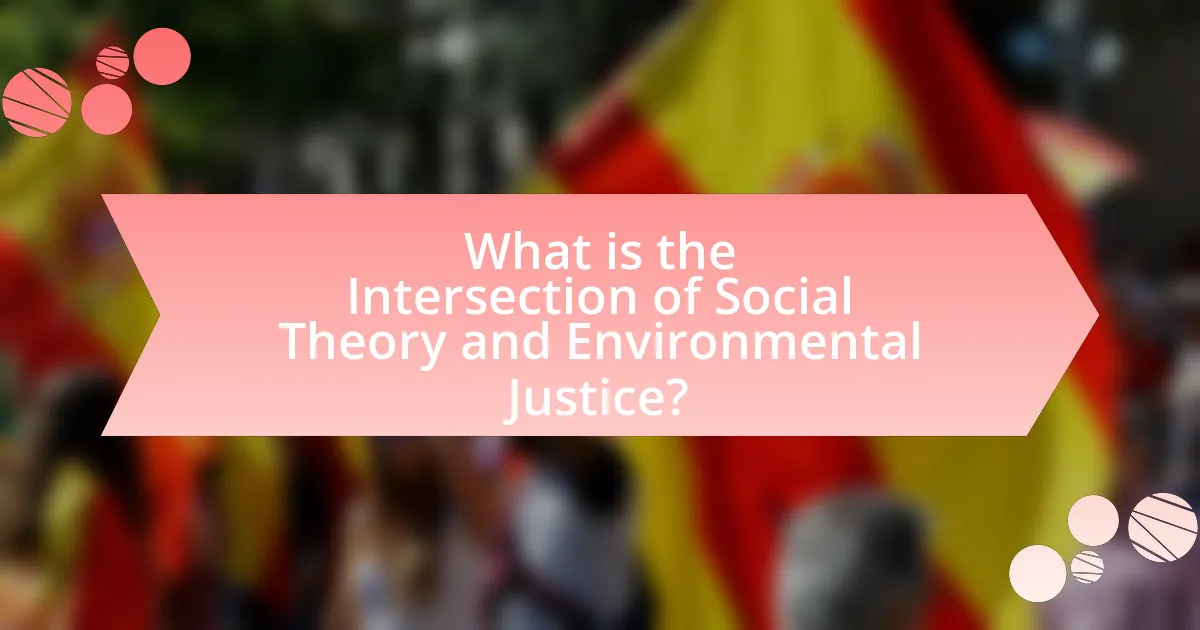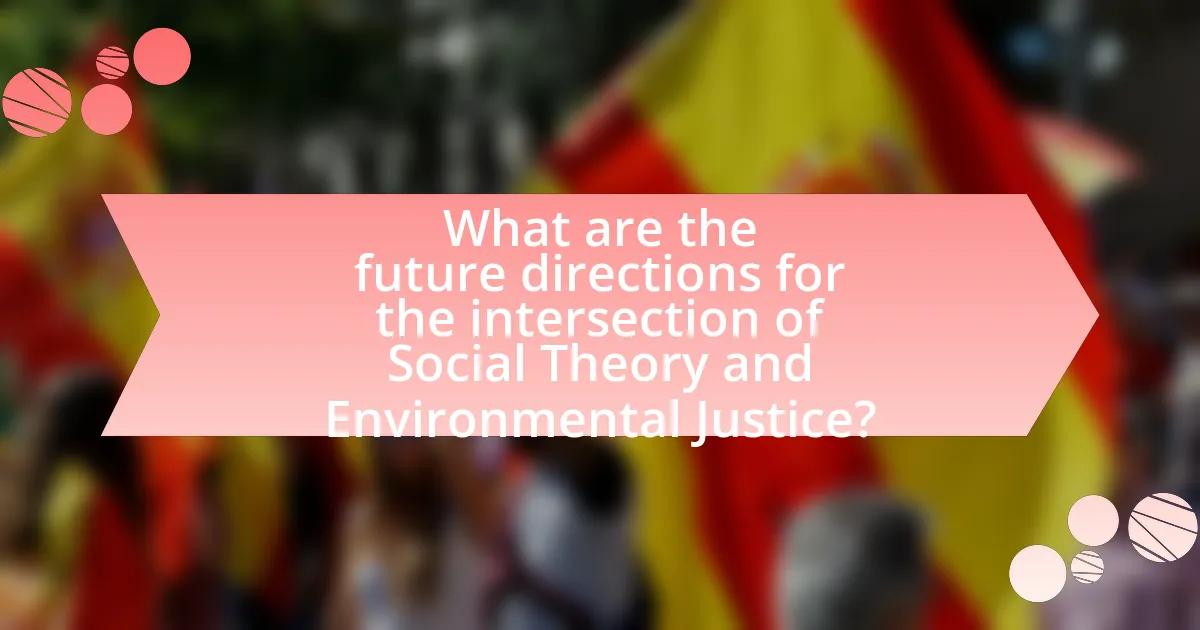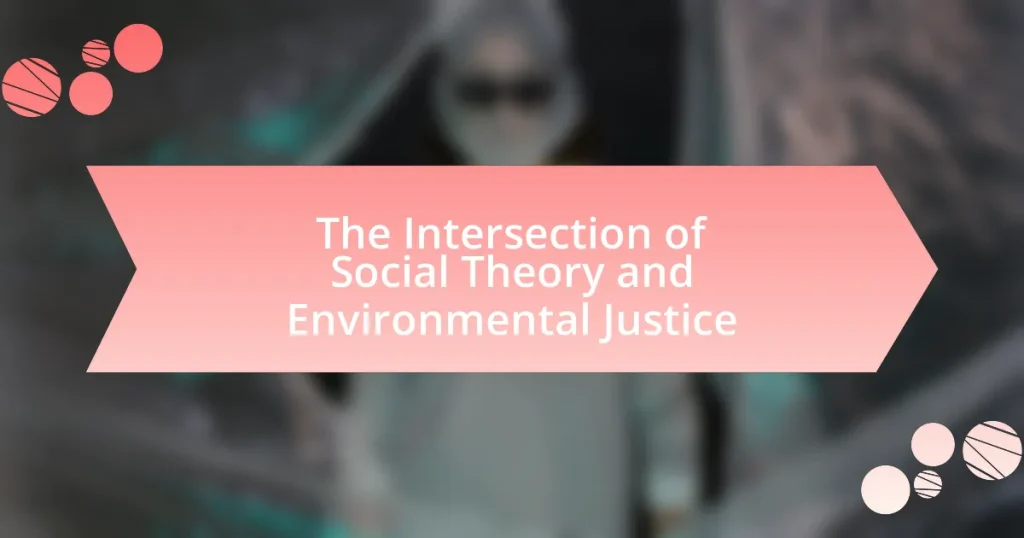The article examines the intersection of social theory and environmental justice, focusing on how social structures, power dynamics, and inequalities shape environmental policies and outcomes. It highlights the disproportionate impact of environmental degradation on marginalized communities, particularly low-income and minority populations, and discusses key social theories such as critical race theory and feminist theory that inform our understanding of these issues. The article also addresses the challenges of integrating social theory into environmental justice practices, the role of public perception, and the importance of interdisciplinary approaches in fostering equitable solutions. Additionally, it explores future directions for research and activism, emphasizing the need for community involvement and collaboration among stakeholders to enhance awareness and action in addressing environmental injustices.

What is the Intersection of Social Theory and Environmental Justice?
The intersection of social theory and environmental justice lies in the examination of how social structures, power dynamics, and inequalities influence environmental policies and outcomes. Social theory provides frameworks to analyze the relationships between marginalized communities and environmental degradation, highlighting that those most affected by environmental issues often belong to disadvantaged social groups. For instance, research shows that low-income and minority populations face higher exposure to pollution and climate change impacts, as evidenced by studies such as the 2018 report by the United Nations which emphasizes the disproportionate effects of environmental hazards on vulnerable populations. This intersection underscores the need for inclusive policies that address both social inequities and environmental sustainability.
How do social theories inform our understanding of environmental justice?
Social theories inform our understanding of environmental justice by providing frameworks that analyze the relationships between social structures, power dynamics, and environmental issues. For instance, theories such as critical race theory and feminist theory highlight how marginalized communities disproportionately bear the burdens of environmental degradation, illustrating systemic inequalities. Research by Robert Bullard, often referred to as the father of environmental justice, demonstrates that communities of color are more likely to be located near hazardous waste sites, which supports the assertion that social theories reveal the intersection of race, class, and environmental policy. Thus, social theories are essential for understanding the complexities of environmental justice and advocating for equitable solutions.
What are the key social theories relevant to environmental justice?
Key social theories relevant to environmental justice include the theory of distributive justice, which emphasizes the fair distribution of environmental benefits and burdens among different social groups. This theory is supported by the work of philosophers like John Rawls, who argues for equitable resource allocation. Another important theory is the social construction of nature, which posits that environmental issues are shaped by social, political, and economic contexts, as discussed by scholars such as William Cronon. Additionally, the concept of environmental racism highlights how marginalized communities disproportionately face environmental hazards, a notion extensively documented in the work of Robert Bullard. These theories collectively underscore the interplay between social inequalities and environmental policies, demonstrating that environmental justice cannot be fully understood without considering social dynamics.
How do these theories address issues of inequality and power dynamics?
Theories addressing inequality and power dynamics, particularly in the context of environmental justice, highlight how marginalized communities disproportionately bear the burdens of environmental degradation. For instance, critical race theory examines how systemic racism influences environmental policies, leading to unequal access to resources and decision-making power for minority groups. Additionally, feminist theory emphasizes the intersectionality of gender and environmental issues, illustrating how women often face greater environmental risks due to socio-economic disparities. Empirical studies, such as those by the Environmental Protection Agency, show that low-income and minority populations are more likely to live near hazardous waste sites, reinforcing the link between power dynamics and environmental inequality. These theories collectively underscore the need for equitable policies that address both social injustices and environmental challenges.
Why is the intersection of these fields important?
The intersection of social theory and environmental justice is important because it provides a framework for understanding how social inequalities influence environmental policies and outcomes. This intersection reveals that marginalized communities often bear the brunt of environmental degradation, as evidenced by studies showing that low-income and minority populations are disproportionately affected by pollution and climate change. For instance, research published in the journal “Environmental Research Letters” highlights that communities of color are more likely to live near hazardous waste sites, demonstrating the critical need for integrating social theory into environmental justice initiatives to address these disparities effectively.
What implications does this intersection have for policy-making?
The intersection of social theory and environmental justice significantly influences policy-making by highlighting the need for equitable resource distribution and inclusive decision-making processes. This intersection emphasizes that policies must address systemic inequalities that disproportionately affect marginalized communities, as evidenced by studies showing that low-income and minority populations often bear the brunt of environmental hazards. For instance, research from the Environmental Protection Agency indicates that communities of color are more likely to be located near hazardous waste sites, necessitating policies that prioritize environmental health and justice. Therefore, integrating social theory into environmental policy frameworks can lead to more effective and just outcomes, ensuring that all voices are heard and considered in the policy-making process.
How can it influence grassroots movements and activism?
Social theory can significantly influence grassroots movements and activism by providing frameworks that help activists understand and address systemic inequalities. For instance, theories such as critical race theory and feminist theory highlight the interconnectedness of social justice issues, enabling grassroots organizations to create more inclusive and effective strategies. Research shows that movements grounded in social theory, like the environmental justice movement, have successfully mobilized communities by framing environmental issues as social justice concerns, thereby increasing public awareness and engagement. This intersection of social theory and activism has led to tangible outcomes, such as policy changes and increased community resilience, demonstrating the practical impact of theoretical frameworks on grassroots efforts.

What are the main challenges at the intersection of Social Theory and Environmental Justice?
The main challenges at the intersection of Social Theory and Environmental Justice include the complexity of social inequalities, the need for interdisciplinary approaches, and the difficulty in integrating diverse perspectives. Social inequalities, such as race, class, and gender, often exacerbate environmental issues, making it essential to understand how these factors influence access to resources and decision-making processes. Interdisciplinary approaches are necessary because environmental justice requires insights from sociology, ecology, and political science to address the multifaceted nature of environmental problems. Additionally, integrating diverse perspectives from marginalized communities can be challenging due to historical power imbalances and differing priorities, which complicates the formulation of equitable solutions.
What barriers exist in integrating social theory into environmental justice practices?
Barriers in integrating social theory into environmental justice practices include a lack of interdisciplinary collaboration, insufficient understanding of social dynamics, and resistance to change within established frameworks. Interdisciplinary collaboration is often hindered by differing terminologies and methodologies between social scientists and environmental practitioners, leading to miscommunication and fragmented approaches. Additionally, many environmental justice initiatives focus primarily on ecological outcomes, neglecting the complex social factors that influence environmental issues, such as race, class, and gender. This oversight can result in ineffective solutions that do not address the root causes of environmental injustices. Resistance to change is prevalent in organizations and institutions that are accustomed to traditional environmental practices, making it challenging to adopt new social theories that could enhance understanding and action. These barriers collectively impede the effective integration of social theory into environmental justice practices, limiting the potential for comprehensive and equitable solutions.
How do systemic inequalities affect environmental justice initiatives?
Systemic inequalities significantly hinder environmental justice initiatives by perpetuating disparities in resource allocation, decision-making power, and access to environmental benefits. For instance, marginalized communities often face greater exposure to environmental hazards due to historical neglect and discriminatory policies, which limits their ability to advocate for equitable environmental protections. Research by the United States Environmental Protection Agency indicates that low-income and minority populations are disproportionately affected by pollution and climate change, highlighting the systemic barriers that impede their participation in environmental governance. These inequalities create a cycle where disadvantaged groups struggle to influence policies that directly impact their health and environment, ultimately undermining the effectiveness of environmental justice initiatives.
What role does public perception play in these challenges?
Public perception significantly influences the challenges faced at the intersection of social theory and environmental justice. It shapes the understanding and prioritization of environmental issues, affecting policy decisions and community engagement. For instance, research indicates that communities with heightened awareness of environmental injustices are more likely to mobilize for change, as seen in the case of the Flint water crisis, where public outcry led to national attention and policy shifts. Furthermore, studies show that public perception can either hinder or facilitate the implementation of environmental policies, depending on the level of trust in institutions and the perceived urgency of environmental issues. Thus, public perception acts as a critical factor in determining the effectiveness of responses to environmental justice challenges.
How can these challenges be addressed?
To address the challenges at the intersection of social theory and environmental justice, it is essential to integrate interdisciplinary approaches that combine social science insights with environmental policy frameworks. This integration can facilitate a deeper understanding of how social inequalities impact environmental outcomes, allowing for targeted interventions. For instance, research by Robert Bullard, often referred to as the father of environmental justice, highlights that marginalized communities disproportionately bear the brunt of environmental hazards, necessitating policies that prioritize equity in environmental decision-making. By employing participatory methods that engage affected communities in the policymaking process, stakeholders can ensure that diverse perspectives are considered, leading to more effective and just environmental solutions.
What strategies can be employed to bridge the gap between theory and practice?
To bridge the gap between theory and practice in the context of social theory and environmental justice, one effective strategy is the implementation of participatory action research (PAR). PAR actively involves community members in the research process, allowing them to contribute their lived experiences and insights, which enhances the relevance and applicability of theoretical frameworks to real-world situations.
Evidence supporting this approach can be found in the work of researchers like Paulo Freire, who emphasized the importance of dialogue and collaboration in education and social change. Additionally, studies such as “Participatory Action Research for Social Justice” by Kindon, Pain, and Kesby highlight how engaging communities in research leads to more effective and sustainable environmental justice initiatives. This method not only validates theoretical concepts through practical application but also empowers communities to take ownership of their environmental challenges.
How can collaboration among various stakeholders enhance outcomes?
Collaboration among various stakeholders enhances outcomes by leveraging diverse perspectives and resources to address complex issues effectively. When stakeholders such as government agencies, non-profits, community groups, and businesses work together, they can pool their expertise, share information, and coordinate efforts, leading to more comprehensive solutions. For instance, a study by the National Academy of Sciences found that collaborative approaches in environmental management resulted in improved decision-making and increased public trust, ultimately leading to better environmental outcomes. This evidence demonstrates that collaboration not only fosters innovation but also ensures that the needs and concerns of all parties are considered, resulting in more sustainable and equitable solutions.

What are the future directions for the intersection of Social Theory and Environmental Justice?
Future directions for the intersection of Social Theory and Environmental Justice include a deeper integration of intersectionality, emphasizing how various social identities impact environmental experiences and outcomes. This approach recognizes that marginalized communities often face compounded vulnerabilities due to systemic inequalities, as highlighted by research from the Environmental Justice Research Collaborative, which shows that low-income and minority populations disproportionately suffer from environmental hazards. Additionally, there is a growing focus on participatory methodologies that empower affected communities to engage in decision-making processes, as evidenced by the work of scholars like Robert Bullard, who advocates for community-led initiatives in environmental policy. These directions aim to create more equitable frameworks that address both social injustices and environmental degradation simultaneously.
How can emerging social theories reshape environmental justice frameworks?
Emerging social theories can reshape environmental justice frameworks by introducing new perspectives on power dynamics, identity, and community engagement. For instance, theories such as intersectionality highlight how various social identities—like race, gender, and class—interact to create unique experiences of environmental injustice. This understanding can lead to more inclusive policies that address the specific needs of marginalized communities. Additionally, social constructivism emphasizes the role of societal norms and values in shaping environmental perceptions, which can inform more culturally sensitive approaches to environmental policy. Research indicates that integrating these theories into environmental justice frameworks can enhance advocacy efforts and promote equitable resource distribution, as seen in case studies where community-led initiatives successfully addressed local environmental issues by leveraging social theory insights.
What role does technology play in advancing this intersection?
Technology plays a crucial role in advancing the intersection of social theory and environmental justice by providing tools for data collection, analysis, and dissemination that empower marginalized communities. For instance, Geographic Information Systems (GIS) enable the mapping of environmental hazards in relation to social demographics, highlighting disparities in exposure to pollution. Research by the Environmental Protection Agency shows that communities of color are disproportionately affected by environmental hazards, and technology facilitates the visualization of these inequities, fostering advocacy and policy change. Additionally, social media platforms amplify the voices of activists and organizations working at this intersection, allowing for greater public engagement and awareness. Thus, technology not only enhances the understanding of environmental justice issues but also mobilizes communities for action.
How can interdisciplinary approaches enhance understanding and action?
Interdisciplinary approaches enhance understanding and action by integrating diverse perspectives and methodologies, which leads to more comprehensive solutions to complex issues. For instance, combining insights from social theory, environmental science, and policy studies allows for a holistic view of environmental justice, addressing both social inequities and ecological impacts. Research by the National Academy of Sciences highlights that interdisciplinary collaboration can improve problem-solving effectiveness, as it fosters innovation and encourages the sharing of knowledge across fields. This integration not only deepens the understanding of systemic issues but also promotes actionable strategies that are informed by multiple disciplines, ultimately leading to more effective interventions in environmental justice.
What practical steps can individuals take to engage with this intersection?
Individuals can engage with the intersection of social theory and environmental justice by actively participating in community-based environmental initiatives. These initiatives often focus on addressing social inequalities related to environmental issues, such as pollution and access to green spaces. For example, joining local advocacy groups that promote sustainable practices and equitable resource distribution can amplify voices that are often marginalized in environmental discussions. Research indicates that community engagement leads to more effective environmental policies, as seen in studies like “Community-Based Environmental Management” by the World Resources Institute, which highlights the importance of local involvement in achieving sustainable outcomes. Additionally, individuals can educate themselves and others about the social dimensions of environmental issues, fostering a deeper understanding of how social structures impact environmental justice.
How can community involvement foster greater awareness and action?
Community involvement fosters greater awareness and action by engaging individuals in collective efforts that highlight social and environmental issues. When community members participate in local initiatives, they gain firsthand knowledge of challenges and solutions, which enhances their understanding and commitment to addressing these issues. For example, studies show that communities involved in environmental clean-up projects report increased awareness of pollution and its effects, leading to more sustainable practices. Additionally, active participation in community discussions and decision-making processes empowers individuals, creating a sense of ownership and responsibility towards their environment. This engagement not only raises awareness but also mobilizes collective action, as seen in successful grassroots movements that have led to policy changes and improved local conditions.
What resources are available for further learning and engagement?
Resources for further learning and engagement in the intersection of social theory and environmental justice include academic journals, online courses, and community organizations. Academic journals such as “Environmental Justice” and “Social Theory and the Environment” publish peer-reviewed articles that explore the theoretical frameworks and empirical studies related to environmental justice. Online platforms like Coursera and edX offer courses on environmental justice, social theory, and related topics, allowing learners to engage with expert instructors and diverse materials. Additionally, organizations such as the Environmental Justice Alliance and the Center for Social Inclusion provide resources, workshops, and events that facilitate community engagement and activism in environmental justice issues. These resources collectively support a deeper understanding and active participation in the field.
